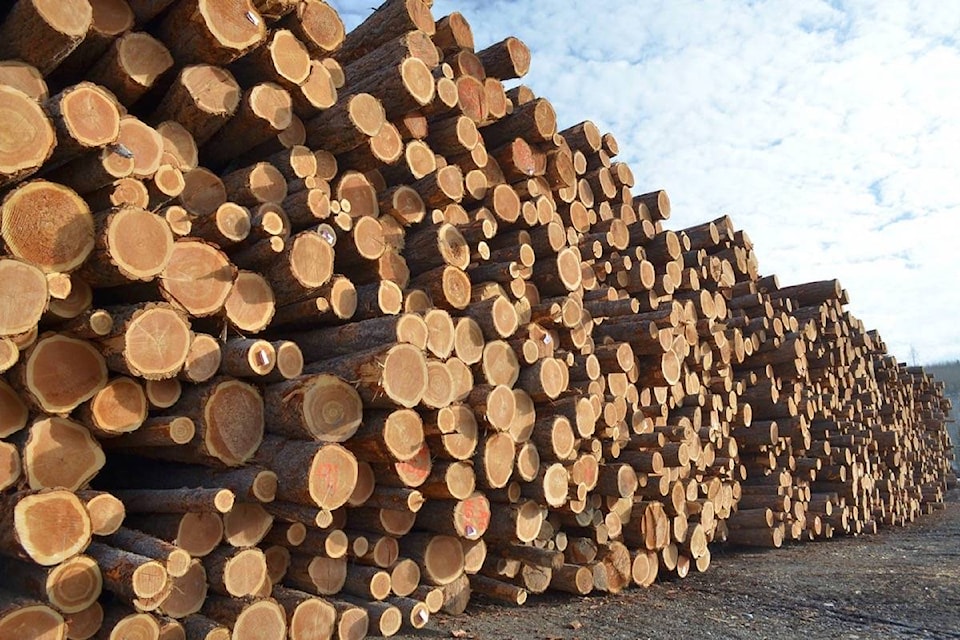The possibility of reduced forestry activity in the near future is sinking in for residents of the Burns Lake region.
The questions, anxieties and calculations of the public follow the provincial government’s release of the Lakes Timber Supply Analysis (TSA) Discussion Paper on April 29 and an open house on May 1.
LOOK BACK: Prospect of lower lumber cut in the air
Though the level of the new Annual Allowable Cut (AAC) won’t be known until the fall, many people are already examining options for a forestry industry different from the one they’ve known for decades.
Speaking to Lakes District News, Burns Lake mayor Dolores Funk takes a glass-half-full perspective of the future.
“It is important to recognize that this decrease in AAC does not include the area-based tenures in the Lakes TSA, such as community forests, woodlots and First Nations Woodlands licenses. These area-based tenures will continue to contribute approximately 500,000 m3 to the local economy and provide a level of stability,” she said.
Her view echoes the fact, pointed out on May 1 by British Columbia’s chief forester Diane Nichols, that the new AAC measures only the timber in the volume-based tenures, and not the area-based tenures.
“The province has announced that they would like to do a pilot in the Lakes TSA allowing for local solutions to local forest management. The Village will work alongside stakeholders and the province to develop opportunities for innovation in the Lakes TSA,” Funk added.
Lakes District News reached out to the Lake Babine Nation for comments on its First Nation Woodland License but didn’t receive a response as of press time.
The mayor’s position is in line with that of Gerry Thiessen, chair of the board of directors of the Regional District of Bulkley-Nechako (RDBN).
“The Lakes TSA discussion paper looks like there will be a significant reduction in the AAC,” he said.
“We will continue to advocate with the province to ensure that all fibre possible is used and not left to burn on the landscape. We continue to look, along with communities in the RDBN, for ways we can diversify the economy in our region.”
Nechako Lakes MLA John Rustad takes a less positive outlook.
“[The TSA] is not starting from a place of what can be done. Rather it seems to be starting from a place of rigid perspective. I’m very concerned about where the AAC may end up and what that will mean for the forest industry in Burns Lake,” he said.
Rustad criticized the lack of government support and policy innovation in the face of challenges to B.C’s forestry industry like high operating costs, a softening housing market south of the border and lower lumber prices.
“If these factors don’t change and if the AAC is dropped too low, I am very worried about the two facilities we have in Burns Lake,” he said.
Rustad’s uncertainty is understandable, and the effects of less timber supply were experienced in the region as recently as 2013, when West Fraser closed down its mill in Houston, affecting 225 jobs. Canfor also closed a mill in Quesnel. The closures were blamed on shortages of merchantable timber because of mountain pine beetle infestations.
LOOK BACK: Houston sawmill to close
However, Rustad is still hopeful of the opportunities for reducing costs and supporting a sustainable industry in the region.
“Perhaps it’s time for government to look at a program to access fibre from Ootsa Lake. It is estimated that there is about 5 million cubic metres of wood that could be harvested with two operations at a rate of about 75,000 m3 a year. This might not sound like a lot but it could make the difference to an operation in Burns Lake for the next generation.”
Steve Zika, Chief Executive Officer of Hampton Affiliates, which owns the Babine Forest Products mill in Burns Lake, said he was not comfortable speculating on outcomes of the timber supply review for the time being.
The current Lakes TSA paper mentioned the economic opportunities in a shift towards more harvests of deciduous species.
Pinnacle Renewable Energy, which owns the pellet plant in Burns Lake is “already leading that shift,” said Jason Fisher, Vice President of Fibre Sustainability.
“We take in deciduous species now to a greater degree than other manufacturers do,” said Fisher, who added that deciduous wood represents less than 10 per cent of Pinnacle’s pellet production.
“Ultimately we’re looking to be as diversified and as omnivorous as we can.”
A drop in the AAC wouldn’t affect Pinnacle directly because it sources its material from the residuals - such as sawdust and bark - which come from the mills.
However, there would be indirect effects.
“Our concern with a lower AAC is if it impacts the mills and they run fewer shifts that lead to reduced residuals that we can use as pellets,” he said.
The solution, in Fisher’s view, depends on how the AAC ends up distributed among forestry companies and mills.
“The best system is one that allows for a diverse group of players in the forest sector, including the pellet sector.”
FLNRORD is welcoming public comments on the timber supply review until July 5.
Blair McBride
Multimedia reporter
Send Blair an email
Like Lakes District News on Facebook
